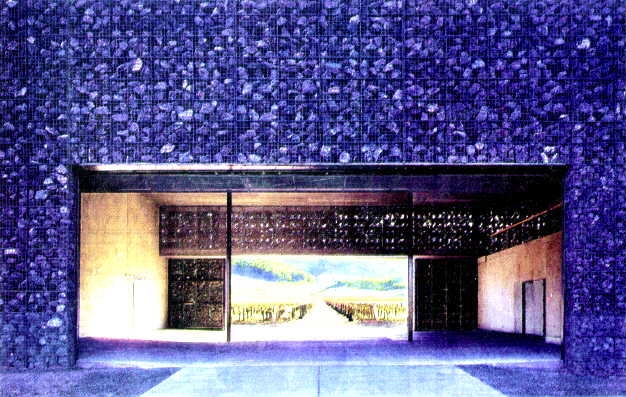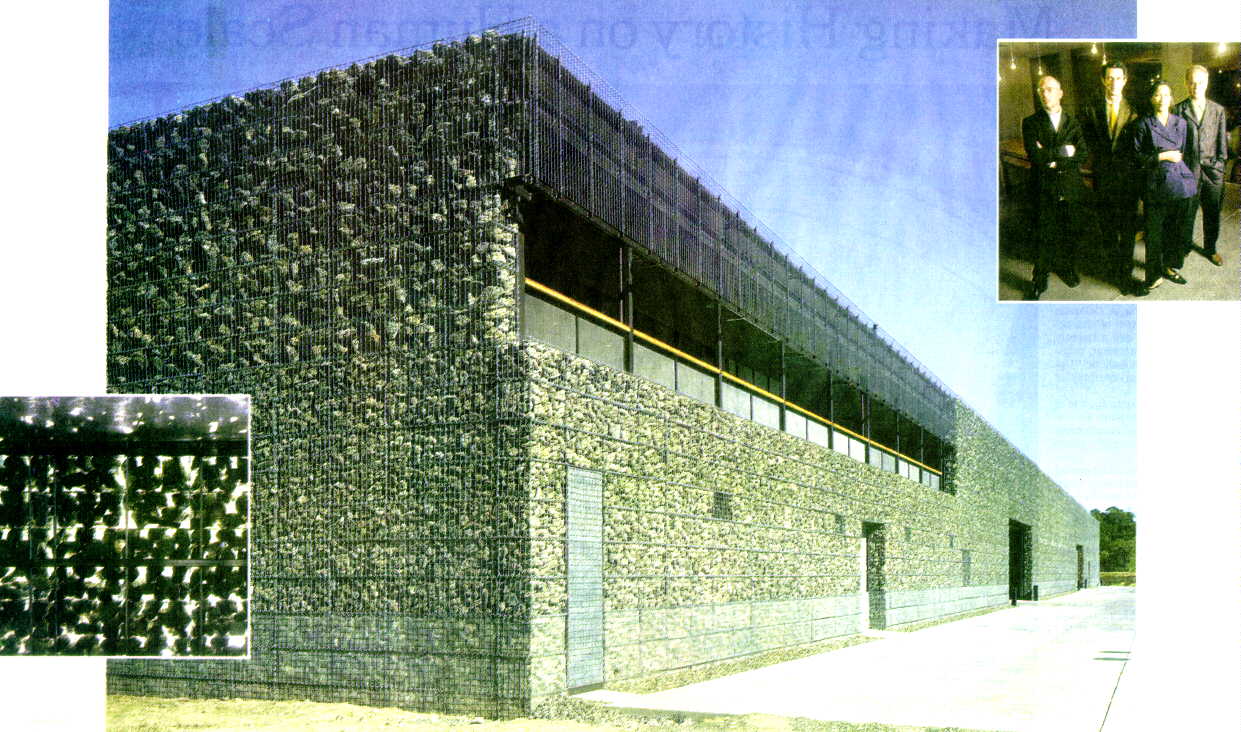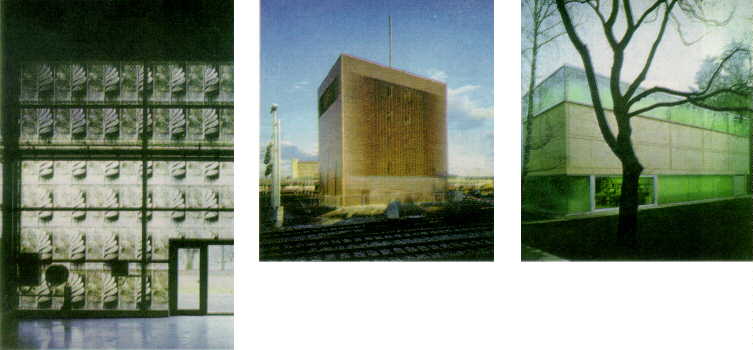
|
Design Notebook
Will the Caged Rock Fly in the Napa Valley?
By Diana Ketcham

SOLID AS LACE The Dominus winery in California has walls
of loose stones held by wire containers.
YOUNTVILLE, Calif.
A LONG Route 29 in Northern California, the main drag of the Napa Valley wine country, most wineries announce their presence with billboard-size gates. At the new Dominus, you see only a long, low building set back among the vineyards. But there is something about this simple stone structure that makes you look twice.
The closer you come, the more the building reveals itself as a conjuror's box of illusions and conceits. The stone walls, so solid-looking from the road, turn out to be stacks of loose stones held in place by wire containers, called gabions. A device used by highway engineers, their ancestors were the stones in wicker baskets that strengthened the walls of Renaissance fortifications. The gabion walls at Dominus, unheard of in modern building, are its most breathtakingly ingenious feature.

ORGANIC The 462-foot-long Dominus is a strong presence among the redwine
vineyards.
The two huge loading bays are where the fall crush takes place.
One of its surprises is that a building so dark and brooding from afar should
have such an animated interior. Its main decoration is the dancing filigree
of light and shadow cast by the curtains of mortarless stone. Who are the
alchemists who have transformed stone into lace?
High-style European architecture has arrived in the Napa Valley thanks to Jacques Herzog and Pierre de Meuron, two architects from Basel, Switzerland, whose Dominus winery building officially opened here on May 6. The partners became the toast of the art world in 1995 when, still in their early 40's, they were chosen to design the new Tate Gallery of Modern Art in London.
This year, they were finalists for the redesign of the Museum of Modern Art in New York. While the art press was busy following their Goetz Gallery, for a private collection in Munich, and the construction of the Tate, Mr. Herzog and Mr. de Meuron were quietly completing the 50,000-square-foot winery here for Christian and Cherise Moueix of Bordeaux, France, makers of the renowned Chateau Petrus.
Some may find it odd that the stylish Swiss architects' first American building is not an urban gallery space, but a workaday building in rural California. In an agricultural landscape much altered by escalating architectural ambition, Mr. Herzog and Mr. de Meuron and the Moueixes have struck a salutary note. Restrained and dignified, their winery is a model of how star architecture can be seemly in its public face even while it offers exquisite pleasures to those who use it. Along with their avid following, the architects have detractors who call their work slick, not so much architecture as art--or worse yet, fashion. Their success in California may go a long way toward proving such labels irrelevant to their work.

Left: Where the stone walls stand alone, a filigree of light is cast into the interior
Center: LOCAL BASALT echoes colors of the Mayacamas Mountains.
In most places, loose stones are arranged over a concrete wall, held by
wire mesh connected to a steel frame.
Right: CONJURERS AND CLIENTS From left, Jacques Herzog, Christian
and Cherise Moueix and Pierre de Meuron. Mr. Moueix began making
wine in the Napa Valley in 1982. The oak barrels are arranged six
across and two deep, a Bordeaux tradition.
Dominus is built on Napanook, one of the valley's historic dry-farmed vineyards. Laid out in the 19th century, the vineyard belonged to the legendary John Daniel, the proprietor of Inglenook. In 1982, Daniel's daughters went into partnership with Mr. Moueix, (pronounced Moe-EX), director of the Bordeaux firm founded by his father, Jean-Pierre Moueix, and began producing Dominus red wine. Mr. Moueix's partners have since dropped out, and his 1997 Dominus Estate vintage was the first made in the new winery.
At first glance, Dominus might be taken for an ordinary winery building, rendered extra-large and ultra-sleek. It is a rectilinear box, its walls blank except for two huge openings for trucks. Devoid of landscaping, even the commonplace Napa roses, it sits in a gravel yard.
"People say our building is like a Stealth bomber that landed in the vineyard," Mr. Herzog said at the opening lunch in Yountville earlier this month. "You don't see it until it's too late."
For there is nothing ordinary about this building. It is not made of Napa's ubiquitous cinder block but of gray-green basalt, which is a local stone, but not a familiar one. The clarity of its silhouette is exaggerated and surreal. Its gravel yard is bare, too bare.
The first rule about the architecture of Herzog & de Meuron is that nothing is quite what it seems. Their buildings are famous for mystery and ambiguity, thanks largely to their shimmering and semi-transparent surfaces. At their factory in France for Ricola, the makers of herbal candy, translucent exterior walls are overlaid with a silk-screened pattern of leaves. The roof channels rainwater down two other walls, making their concrete gleam like glass. The wetness leaves traces of moss that form yet another pattern. Such facades delight the mind and senses, at the same time hiding, or selectively revealing, the building's structure and interior space.
Both born in Basel in 1950, the architects were schoolboy friends who went into partnership in 1978. Through the early 90's, they worked in and around their native city, which borders France and Germany in northwestern Switzerland. Their crucial work from this period is their 1992 Signal Box in the Basel railroad yards, a six-story concrete high-rise containing switching equipment. A tour de force of illusionism and eerie beauty, it is wrapped in twisted copper strips that conceal floors and windows. A dull blank box on a cloudy day, it glows at night like a giant incandescent battery.
There was a practical reason for the young architects' lavish use of copper: copper over concrete was their solution for the insulation of vital electronic equipment. Visually, the horizontal banding changes a boring industrial box into an elegant geometric form that seems perfectly at home in the gritty vastness of the train yard.
Like the Signal Box, Dominus is surprising yet pleasing in its workaday setting. The portals of the two loading bays frame grand vistas: they are powerful framing devices that draw the vineyards closer.
The winery's diaphanous stone facade links it to the architects' European work. Mr. Herzog and Mr. de Meuron are often associated with the new glass architecture movement, exemplified by Jean Nouvel's Fondation Cartier and Arab Center in Paris, which uses layers of glass, translucent panels and perforated metal to treat the facade chiefly as means of manipulating the flow of light. The effect is to deny the traditional role of walls as barriers.
To some critics, these European designers are heroes for bringing beauty and mystery back into architecture. Others fault them for what they call cheap thrills, weakness of plan and structure, and a subjectivity that puts the interests of clients last. (In a celebrated furor, reminiscent of the famous leaking roofs in some Frank Lloyd Wright houses, an early all-glass plan by Dominique Perrault for Paris's Bibliotheque Nationale in Paris was faulted for exposing the nation's books to incineration by sunlight. The design as built includes protective metal and wood.)
Such criticisms are rarely applied to the Swiss architects. Yet they take this trend even further in the direction of unabashed artfulness. They use luxurious materials and make plain ones glitter. They silk screen on concrete and glass. They print their facades with art (or photographs chosen by artists like Thomas Ruff).
In interviews, the partners speak reverentially of Andy Warhol, who taught them about repetitive pattern, and of their countryman Joseph Beuys, the artist who taught them about materials. "Beuys's sensual approach to materials was so different from the mono-functional approach of most architects," Mr. Herzog once said.
For Ms. Moueix, it was the architects' generation and art world savvy that made them easy to work with. An American and the former director of the Marian Goodman Gallery in Paris, she had first admired their buildings years before the Tate hoopla, when she attended the Basel Art Fair.
"Since the four of us were about the same age, we could have real conversations," she said. "I could tell Jacques and Pierre that I wanted the credenza in the seminar room to 'float like a Donald Judd,' and they knew exactly what I meant."
The critical establishment, on the other hand, remains a bit uneasy with Herzog & de Meuron. Contemporaries like Rem Koolhaas have questioned their work's intellectual substance. Can truly good architecture use decoration so blatantly? Can it be so happily sensuous? Can it be so attractive? Should Herzog & de Meuron be designing a line of clothing or fabrics instead?
Mr. Herzog's mother was a tailor. "I liked growing up with textiles all around," he said, without a shred of apology. "We make architecture, not art or fashion, but we try to give every building something that attracts people. Being attracted is what leads people to experience architecture and want to understand it."
If you think of it as textile, the imitation stone wall at Dominus is the ultimate Herzog & de Meuron conceit. It is the fabric they have invented to dress (yet undress) their building, embodying the paradox of strong masonry as something delicate and lacy.
The architects justify their stone curtains as functional. They form a screen in front of concrete walls in much of the building, shading them from Napa's searing sun. "The gabions create an above-ground 'cave,' where wine is surrounded by a stone mass that breathes," Mr. Herzog said. Still, there is air-conditioning for backup. The owners would not state the cost of the winery but said the gabions allowed them to use less expensive concrete elsewhere.
No one would call Dominus easy architecture. Yet no one knows how to label it: is it decorative or minimalist? Beautiful and dumb or too clever by half? Though immensely thoughtful, the Swiss partners are not members of the avant-garde and have been criticized as conservative. Unlike their Los Angeles contemporaries, for example, they are not driven to analyze form by breaking it into fragments. They are content with the old-fashioned geometry of Euclid and Descartes. Nor do they search out radically new materials: they just decorate the old ones. Their pleasure-giving work is short on anxiety and dislocation, the emotional pieties of today's avant-garde.
If it's befuddling to the critics, will it play in Napa? At the opening lunch, a local businessman, who liked the architecture, admitted that some neighbors might not get it. "The building's too modern," he said. "With owners from Bordeaux, and a classic wine, they expect something more classic, more like . . . well, more like a chateau."
He could tell the neighbors that Dominus is already a classic.
THE Swiss architects Jacques Herzog and Pierre de Meuron surround simple rectilinear boxes with an air of ambiguity. Masters of light and reflection, they surface their buildings with layers of glass, translucent panels, strips of metal or, in the case of Dominus (above), loose mortarless stone in wire-mesh containers. The stone facade links it to the architects' European work, below. Their Signal Box in the Basel train yard, copper over concrete, produces a Faraday cage that insulates the electronic switching equipment used to keep Swiss trains on time. At the Ricola factory in France, printed panels by the photographer Karl Blossfeldt create dappled light within and a mysterious sheen on the outside. The walls are an example of the all-over repetitive pattern that is a trademark of their work. The private Goetz Gallery in Munich displaces windows with translucent panels at its upper and lower edges.

MYSTERY From left, Ricola factory's printed panels create dappled
light;
Signal Box, wrapped in copper, glows from within;
Goetz Gallery's translucent panels. Critics ask, can truly
good architecture use decoration so blatantly?
[End]